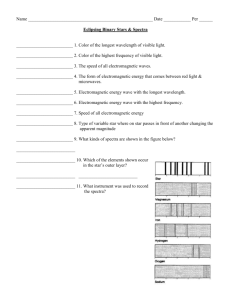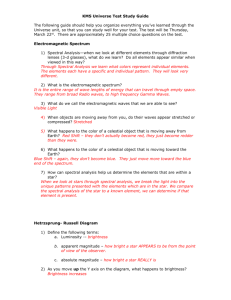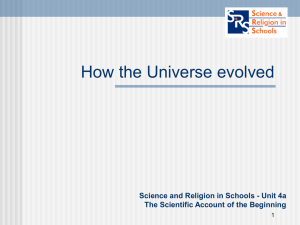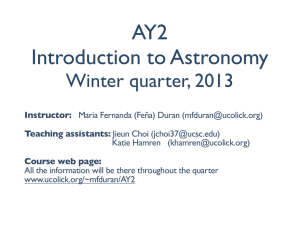Section 1: A Closer Look at Light
advertisement
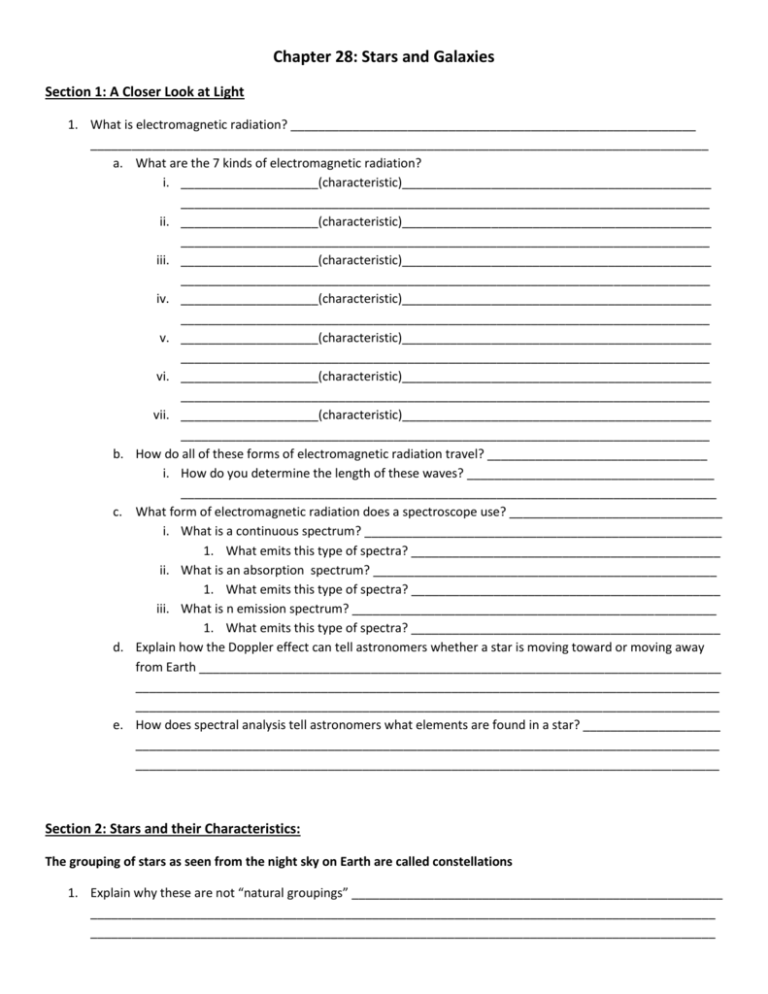
Chapter 28: Stars and Galaxies Section 1: A Closer Look at Light 1. What is electromagnetic radiation? ___________________________________________________________ __________________________________________________________________________________________ a. What are the 7 kinds of electromagnetic radiation? i. ____________________(characteristic)_____________________________________________ _____________________________________________________________________________ ii. ____________________(characteristic)_____________________________________________ _____________________________________________________________________________ iii. ____________________(characteristic)_____________________________________________ _____________________________________________________________________________ iv. ____________________(characteristic)_____________________________________________ _____________________________________________________________________________ v. ____________________(characteristic)_____________________________________________ _____________________________________________________________________________ vi. ____________________(characteristic)_____________________________________________ _____________________________________________________________________________ vii. ____________________(characteristic)_____________________________________________ _____________________________________________________________________________ b. How do all of these forms of electromagnetic radiation travel? ________________________________ i. How do you determine the length of these waves? ____________________________________ ______________________________________________________________________________ c. What form of electromagnetic radiation does a spectroscope use? _______________________________ i. What is a continuous spectrum? ____________________________________________________ 1. What emits this type of spectra? _____________________________________________ ii. What is an absorption spectrum? __________________________________________________ 1. What emits this type of spectra? _____________________________________________ iii. What is n emission spectrum? _____________________________________________________ 1. What emits this type of spectra? _____________________________________________ d. Explain how the Doppler effect can tell astronomers whether a star is moving toward or moving away from Earth ____________________________________________________________________________ _____________________________________________________________________________________ _____________________________________________________________________________________ e. How does spectral analysis tell astronomers what elements are found in a star? ____________________ _____________________________________________________________________________________ _____________________________________________________________________________________ Section 2: Stars and their Characteristics: The grouping of stars as seen from the night sky on Earth are called constellations 1. Explain why these are not “natural groupings” ______________________________________________________ ___________________________________________________________________________________________ ___________________________________________________________________________________________ 2. Explain how constellations appear to move across the sky over the course of a day and a year a. Day: _______________________________________________________________________________ b. Year: _______________________________________________________________________________ ____________________________________________________________________________________ 3. What is apparent magnitude? _________________________________________________________________ a. Explain the numeric system used to describe the brightness of star as seen from Earth _____________ _____________________________________________________________________________________ _____________________________________________________________________________________ i. Example of bright star and apparent magnitude: _______________________________________ ii. Example of a dim star and its apparent magnitude: _____________________________________ 4. What is absolute magnitude? __________________________________________________________________ a. What does this have to do with luminosity? _________________________________________________ _____________________________________________________________________________________ _____________________________________________________________________________________ _____________________________________________________________________________________ b. What does this end up being a comparison of? _______________________________________________ 5. What is an astronomical unit? __________________________________________________________________ a. Where is this unit used in determining distances in space? _____________________________________ 6. What is a light year? __________________________________________________________________________ a. How far is that? ________________________________________________________________________ 7. What is a parsec? _____________________________________________________________________________ a. How far is that? ________________________________________________________________________ 8. Explain how parsecs and parallax are related _______________________________________________________ ___________________________________________________________________________________________ ___________________________________________________________________________________________ 9. Explain the difference between mass and size in stars ________________________________________________ ___________________________________________________________________________________________ ___________________________________________________________________________________________ 10. What about stellar density? ____________________________________________________________________ 11. Stars also vary in temperature, which will affect their color. What are the colors associated with temperature from hottest to coolest? a. _________________________________________ b. _________________________________________ c. _________________________________________ d. _________________________________________ e. _________________________________________ f. _________________________________________ 12. What is a Cepheid variable star and how is it different from a “regular” star? _____________________________ ___________________________________________________________________________________________ a. How do astronomers use Cepheid variable stars to determine distance to other galaxies? ____________ _____________________________________________________________________________________ 13. What is an eclipsing binary star? Is it only one star? _________________________________________________ ___________________________________________________________________________________________ Section 3: Life Cycles of Stars 1. What are the 4 main categories of stars on the Hertzsprung-Russell Diagram? a. _______________________________________________________ b. _______________________________________________________ c. _______________________________________________________ d. _______________________________________________________ 2. In the diagram below, list the phases of the stars’ life Section 4: Galaxies and the Universe 1. What is a galaxy? _____________________________________________________________________________ 2. How many galaxies are in our universe? ___________________________________________________________ 3. There are 3 typical types of galaxies list them below with a few characteristics for each type a. __________________( characteristics) _____________________________________________________ _____________________________________________________________________________________ _____________________________________________________________________________________ b. __________________(characteristics) _____________________________________________________ _____________________________________________________________________________________ _____________________________________________________________________________________ c. __________________(characteristics) _____________________________________________________ _____________________________________________________________________________________ _____________________________________________________________________________________ 4. What are active galaxies and quasars? ____________________________________________________________ ___________________________________________________________________________________________ ___________________________________________________________________________________________ 5. What is the Big Bang Theory? ___________________________________________________________________ ___________________________________________________________________________________________ ___________________________________________________________________________________________ ___________________________________________________________________________________________ ___________________________________________________________________________________________

